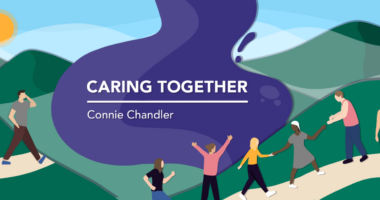Introducing ‘Caring Together’: My journey with friendship caregivers
How I learned to instruct and request help from my community

In 2001, I was a bright-eyed college freshman, ready to change the world with my bleached highlights, cargo pants, and purple-framed power wheelchair. I felt like I had already achieved and overcome so many things in the 18 years since I was diagnosed with spinal muscular atrophy type 2 — things no one thought would be possible. So as I moved into my dorm room on campus and reviewed my class schedule for the hundredth time, I was fearless and excited. I wouldn’t let my disability define or limit me!
I never would’ve guessed that just two weeks later, after attending an amazing campus group event, I’d be on the phone with my mom, dramatically blubbering: “This really cute guy asked me if I was going on the fall retreat, and I really want to! And you know I love you, but I don’t want you to come with me! I’m going to miss out on everything because I don’t know anyone who can help me.”
Even though I thought I was independent and invincible, I was (and still am) far from it. Because of this rare genetic disease that I have, my muscles are very weak, especially in my arms, legs, and back. Not only can I not walk, but there are many things I can’t do for myself, like getting out of bed, taking a shower, cutting up my food, and opening doors.
Part of my social confidence throughout high school stemmed from my mom going on every trip with me as my caregiver (and, conveniently, an adult chaperone). Mission trips, lock-ins, weekend getaways — we did it all together. She was a superhero about doing all of my care behind closed doors and then discreetly fading into the background so I could look and act as normal as possible around my friends. But I had made the decision to go out into the world and claim my independence, and at the first real test, I panicked.
“OK, here’s what we’re gonna do,” Mom said that night on the phone. “You’re going to take some deep breaths and blow your nose and wash your face, and then we’re gonna just pray that God will make a way.”
The next day in the cafeteria, this cool, sassy, lovely girl smiled and waved me over, and I recognized her as the emcee of the previous night’s event. When I got close, she said, “Hey, are you not going on the fall retreat because you need a caregiver? Because, if so, I’ll do it, and I’m sure some of the other girls will, too. We don’t know what to do, but if you teach us, we’ll figure it out together.”
That initial offer and the experience I had at the fall retreat changed my life; I met some incredible friends who are still very special to me. They learned various levels of care as the year went on, from carrying my dinner tray in the cafeteria, to driving my van, hoisting me up a flight of stairs, helping me in the restroom, and washing and styling my hair. And I learned how to ask for help, be clear in instructing, patient in adjusting, and gracious in growing with my new community.
Today, I live in my own home and depend on a team of about 25 volunteer friendship caregivers who do daily things for me and with me, so that I can have a full and active life. You can learn more about how that happened and how that’s going on my personal blog.
It’s not easy to engage untrained friends and peers in caregiving. Even with 20 years of experience, I struggle to admit my needs and risk vulnerability. Sometimes it’s challenging to be my own advocate, trainer, and supervisor, or to be flexible with my expectations of others’ abilities and capacities. No, it’s not easy, but it is so beautiful.
In the weeks to come, I hope to share with you more personal stories about friendship caregiving and how it has enriched my life and the lives of the people around me. And I hope that these stories will encourage, inspire, and empower you to invite your friends into your disability journey and care, too.
Follow me on Instagram and Facebook!
Note: SMA News Today is strictly a news and information website about the disease. It does not provide medical advice, diagnosis, or treatment. This content is not intended to be a substitute for professional medical advice, diagnosis, or treatment. Always seek the advice of your physician or other qualified health provider with any questions you may have regarding a medical condition. Never disregard professional medical advice or delay in seeking it because of something you have read on this website. The opinions expressed in this column are not those of SMA News Today or its parent company, Bionews, and are intended to spark discussion about issues pertaining to spinal muscular atrophy.







Leave a comment
Fill in the required fields to post. Your email address will not be published.